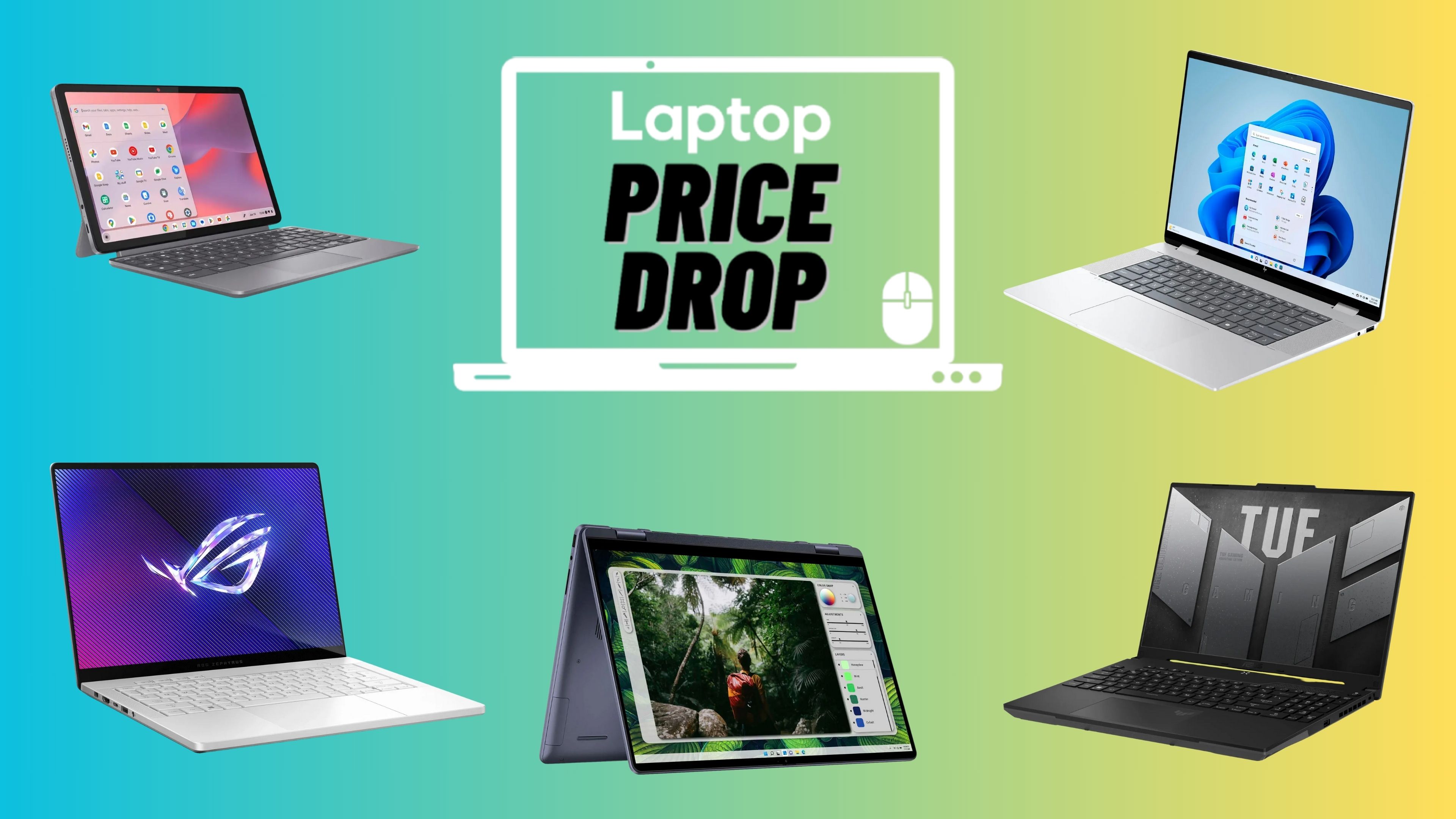Laptop Mag Verdict
HTC has created a worthy successor to the original Android phone, which is also the first handset to deliver 4G data speeds on T-Mobile.
Pros
- +
Snappy performer
- +
Spacious keyboard
- +
Fast HSPA+ data
- +
Excellent call quality
- +
Long battery life
Cons
- -
Comes pre-loaded with several apps that can't be removed
- -
Hinge design raises durability concerns
- -
Tethering disabled
Why you can trust Laptop Mag
It's hard to believe that just two years ago T-Mobile introduced the G1, and the Android OS, to the world. That handset kicked off the Android revolution, and from then until now we've seen an explosion of phones and the continued rise of HTC as a major player in the mobile market. The $199 G2 is a worthy sequel to the first Google phone, representing much of what is good about the operating system and much of what HTC has learned from the many handsets that came between then and now. The G2 is also the first smart phone to ride on T-Mobile's growing HSPA+ network, offering 4G-like speeds in more than 65 markets. What's not to like? Not much.
Design
While the G2 is an update to T-Mobile's G1, it's more of a descendant of the Google Nexus One, another HTC phone. The corners aren't as rounded as the Nexus One's, but the capacitive touch buttons and placement of the optical trackpad echo the older phone. Despite the addition of a keyboard, the G2 manages to be almost as slim as the Nexus One, measuring only 0.56 inches thick--just 0.06 inches thicker.
The mix of aluminum and slightly rubberized plastic for the casing gives the G2 an air of seriousness and solidity; the plastic doesn't make the phone look cheap and the metal doesn't stand out too starkly against it. It also feels good in the hand, as the corners and edges have just enough roundness to feel comfortable no matter how we held it. At 6.5 ounces the G2 is noticeably heavier than the Motorola Droid 2 (6 ounces) and the Samsung Epic 4G (5.5 ounces), and you'll definitely feel the weight; however, that helps the phone feel solid.

Click to enlarge

Click to enlarge
HTC's boldest design choice with the G2 is the mechanism for accessing the keyboard. Instead of sliding open flush with the chassis, the G2 has a Z-hinge that lifts the display up a bit before snapping open into place. This up-and-over movement is easy and smooth enough, but looking at the thin, plastic "legs" of the hinge, we wonder if it will last a full two years. Also, we can easily see dirt, crumbs, or even pieces of paper getting trapped in the space between the two halves of the phone. When typing on your back--say, while lying in bed--the display may hang downward.
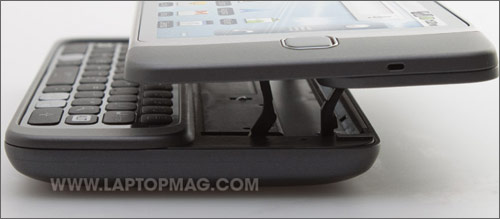
Click to enlarge
Keyboard and Trackpad
Overall, the typing experience on the G2 was quite good. The keyboard is somewhat reminiscent of that on the MyTouch 3G Slide; the keys themselves are large and there's plenty of space between them. As the keys are slightly pillowed and have a bit of roughness to the surface, users with fingernails may find the G2 slightly more uncomfortable to type on than those who use the pads of their fingers. While the keys on the Motorola Droid 2 are stiff, the G2's layout feels somewhat mushy. The Epic 4G still offers the best typing experience among Android phones.
While there's no number row, we like that there's a dedicated .com/www. key, a wide space bar, and two wide Shift keys. The G2 also includes a Menu and Search button on the keyboard, but no voice-to-text button as there is on the Droid 2's keyboard. However, the bottom row includes three user customizable Quick Keys. Users can assign a variety of shortcuts and apps to these keys, including some app-specific functions such as Bookmarks in the default browser.
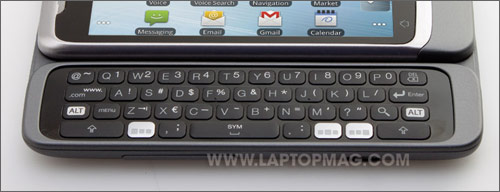
Click to enlarge
For those times you don't want or need the physical keyboard, the G2 comes pre-loaded with Swype, one of our favorite Android on-screen keyboards. Users can type normally or swipe from letter to letter without having to lift their finger. Additionally, the G2 also comes with a software keyboard that is already activated (pictured below).
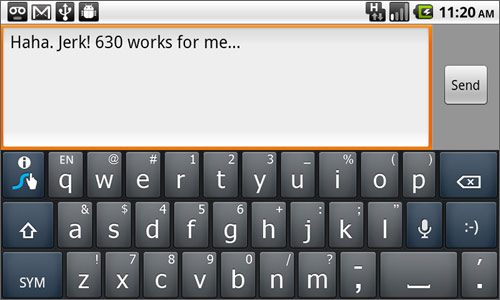
Click to enlarge
The optical trackpad that sits beneath the buttons under the display is a welcome replacement for the G1 and Nexus One's trackball. Though small--just 0.35 inches square--we found it easy to move the focus/cursor with a flick or roll of the thumb, just as with a ball. Plus, the trackpad won't pop out or get gummed up with dirt as easily. A thin, white LED strip surrounds the trackpad's outline, serving as the LED notification light.
Display
The 3.7-inch, WVGA 800 x 480 res display is beautiful and crisp, and a good deal better than the MyTouch 3G Slide (3.4 inches, 480 x 320). However, when compared to the display on the Droid 2, the G2's colors and whites didn't pop quite as much. This panel pales in comparison to the Samsung Epic 4G's vibrant Super AMOLED display. Still, when watching video recorded on the G2 or streamed from YouTube, we were more than satisfied with the quality of the screen. Viewing angles are wide, so when sharing an HD video with a few friends, everyone will be able to see the image.
We found that when tapping the display and using the on-screen keyboard, we had to be more accurate with our placement than we're used to on other Android phones. The calibration wasn't off; the screen was just less forgiving of imprecise taps.
Interface
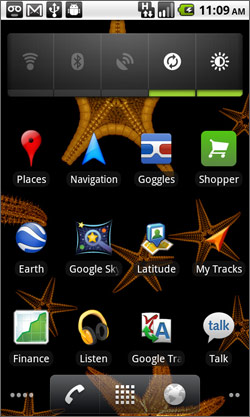
Click to enlarge
The G2 offers a mostly "pure" Android 2.2 experience, forgoing HTC Sense in favor of the stock Android UI. This will presumably make it easier for T-Mobile to keep up with Google's OS updates, but it also means forgoing the great apps and widgets that come with HTC Sense. Still, while proprietary interfaces serve to help distinguish Android phones from each other, it's a shame that fewer don't keep some of the graphical elements of the stock Android 2.2 OS (Froyo). We love the way icons scroll under All Applications (rolling up in 3D in a way reminiscent of the Star Wars scroll), and we also like the nicely designed Home screen buttons.
Apps
Though the G2's interface is stock, the pre-loaded apps are not. The G2 comes with every Google app available. Aside from Gmail, Maps, and YouTube, which are usually standard with Android, there's also Earth, Goggles (pictured), Finance, Latitude, Listen (for podcast management), Places, Navigation, Shopper, Sky Map (for stargazing), Talk, Tracks, Translate, and Voice. Some users might consider some of these bloatware since you can't delete these apps. But they're all from Google, and not at all useless. Nevertheless, some will find it annoying that they can't delete programs they find unnecessary.
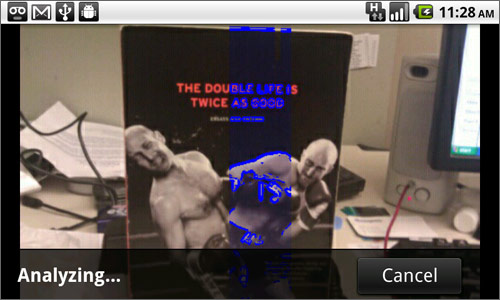
Click to enlarge
Of the benefits these pre-installed apps offer, we particularly appreciated the tight integration with Google Voice. Not all handsets are set up to allow Google Voice to work with the phone's voicemail out of the box, but here the setup was easy.
The G2 also comes pre-loaded with Facebook, Photobucket, QuickOffice, and Twitter. Not much has been done to enhance stock apps such as Music, Calendar, and Clock/Alarms.
Specs and Performance
In a time when 1-GHz processors are almost standard on new Android phones, it's surprising that HTC would include an 800-MHz Qualcomm MSM 7230 CPU in the G2. It's even more surprising that this doesn't seem to have adversely affected its performance. Perhaps this is because the G2 doesn't have to worry about powering a second interface. Either way, apps loaded quickly, we noted no stuttering when swiping between screens, and overall found the phone very responsive.
Benchmark scores backed up our impressions. On Linpack, the G2 scored 28.69, more than double the score of most Android phones, including the Motorola Droid 2 and the Droid X (running Froyo). However, the Nexus One and the HTC Evo 4G (both running Froyo) beat the score by a few points (31.84 and 33.8, respectively). In Benchmark, the G2 scored well on the CPU test; its score of 1763.3 bested only by the Evo 4G and Nexus One, though the Droid 2 comes close (1706.4). It has the highest Benchmark Memory score of the Android handsets we've tested; 456.1.
In the graphics department, the G2 is average overall. The phone earned a score of 23.2 in Graphics on Benchmark, below the Samsung Epic 4G, Droid 2, and Evo 4G, though above the Nexus One by a hair. In FPS2D, which measures 2D graphics performance, the G2 got a solid 57fps, which is on the higher end of the curve. In An3DBench for 3D performance, the G2 notched 5,933, above the Nexus One and Evo 4G, less than 100 points above the Droid X, but significantly below the Epic 4G and the Droid 2.
Web and Connectivity Speeds
The G2 is T-Mobile's first HSPA+ phone, and we found many pockets of this 4G-like connectivity in New York City. Using Speedtest.net, we measured download speeds from 1.8 to 3.1 Mbps 3184 and uploads in the 1.3 Mbps range while the phone displayed an H in the top right corner (indicating we were in HSPA territory). However, there were times when the G2 fell back to EDGE data, which slows down the experience.
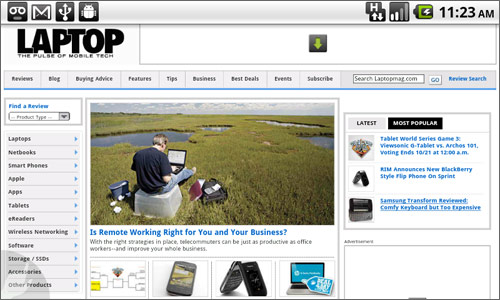
Click to enlarge
Over HSPA+, we downloaded three websites in three different locations. The full version of Laptopmag.com loaded in 23 seconds with 2 bars and 7 and 9 seconds with full bars. The mobile version of MSNBC.com loaded in 9 seconds with 2 bars and 6 to 7 seconds with full bars. The mobile version of CNN.com loaded in 11 and 4 seconds, respectively under the same circumstances. Flash video playback over HSPA was halting; over Wi-Fi the Late, Late Show on CBS.com/video loaded quickly, and while the image was not very crisp, it was watchable.
Unfortunately, users won't get to experience HSPA+ on their notebooks as T-Mobile disabled Android 2.2's native tethering functionality. The carrier says they hope to include this in a future update.
Multimedia
On the back of the G2 sits a small, thin speaker that's fairly loud, but sounds harsh when turned all the way up. We'd listen to music just one or two notches down form 100 percent. As we mentioned, watching video is pleasurable due to the wide viewing angles. The G2 easily handled high-quality video clips in the YouTube app.
Camera
The G2's 5-MP camera records 720p video at 24fps. When compared to the Samsung Epic 4G's camera, the footage looked less vibrant and had more of a bluish tint. We also noticed that fast-moving objects were less distinct. The Epic 4G's image is also crisper, and colors are truer. We noticed this when filming both inside and outside.
Compared to the Droid 2, the G2's colors are more vibrant, though the G2's camera doesn't balance light and dark as well as the Droid 2.
Still images exhibited a good amount of color, depth, and crispness, even in low light. Colors popped more than images taken with the Epic 4G and the Droid 2, but sometimes had too much shadow. A decent spread of settings means some users will be able to leave the point-and-shoot at home. However, we were disappointed to find that zoom only goes to 2x.
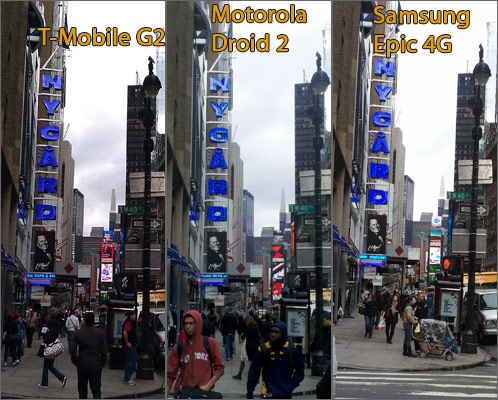
Click to enlarge
Call Quality

Click to enlarge
When using the G2, friends reported that we sounded crisp and clear even with minor background noise. When we made a call with Google Voice, the quality wasn't as good, but our voice still came through distinctly. The Droid 2's audio sounds a bit muddy in comparison.
Battery Life
We were pleased to find that with moderate to heavy use, the G2 was able to last a workday on a full charge. Even as it switched between EDGE and HSPA with updates from Facebook, GMail, Twitter, and a few other apps downloading on a regular basis, the battery didn't give out on us until late evening.
Verdict
The $199 T-Mobile G2 definitely does Android proud. It combines a mostly solid design with fast overall performance and zippy data speeds (where available). We're not sure the up-and-over design for the keyboard was necessary, but T-Mobile subscribers looking for a fast and stylish QWERTY phone will find the G2 a solid successor to the original Google phone.
T-Mobile G2 Specs
| Bluetooth Type | Bluetooth 2.1 EDR |
| Brand | HTC |
| CPU | 800 MHz Qualcomm MSM 7230 |
| Camera Resolution | 5 MP |
| Carrier | T-Mobile |
| Company Website | http://www.htc.com |
| Data | GPRS/EDGE/HSDPA/UMTS |
| Display (main) | 3.7 inches |
| Form Factor | QWERTY Slider |
| GPS | Yes |
| Internal Memory | 4GB |
| Memory Expansion Type | microSDHC |
| Networks | GSM, UMTS |
| Operating System | Android 2.2 |
| Ports | 3.5mm headphone, microUSB |
| RAM | 512MB |
| Size | 4.7 x 2.4 x 0.56 inches |
| Talk / Standby Time | Up to 590 minutes/Up to 430 hours |
| Weight | 6.4 ounces |
| Wi-Fi | 802.11b/g/n |
